This has been a funny ‘ole few weeks: I’ve been working on my writing, using various ‘writing prompts’ to help me tease out memories and stories. The output has astonished me with what has come to light, out of my brain and into words. Stories I had long forgotten, memories that had not surfaced so clearly before. It has also been a period where a lot of sad stories and emotionally difficult rememberings have spun out of me.
In one of these less traumatic memories, however, I recalled a time in California with poison oak, and how every day for four years I walked through big patches of it to and from high school. For those of you who aren’t familiar with poison oak, it is a common vine or shrub found in dry or moist woodland, grassland or chaparral throughout the Western United States1. Why yes, it grows EVERYWHERE.
If you are sensitive to it, you suffer from itchy bumps on your skin that lasts from a few days to several weeks. As kids, we learned to identify it by the catch-phrase: “Leaves of three, let it be”.
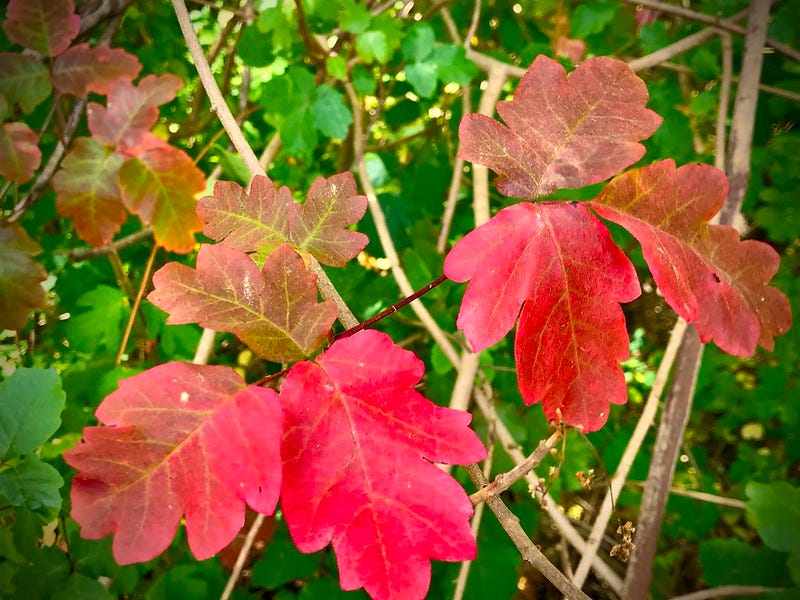
Our house was on a steep hill behind the school, and I walked down through a forest and across a creek to get there. Using this shortcut, I could get to school in about 15 minutes. In the winter and after big rainstorms, I had to walk the long way around on the streets because the creek would have turned into a fast-flowing river with no way to cross. The mud in the forest would turn into a steep slip-slide chute too treacherous to navigate in school shoes. On rainy days it took well over 30 minutes to walk to school.

Over those four years I almost always had a slight case of itchy skin. I actually got more and more sensitive to to it over time, so every month or so I would be getting, treating, or recovering from a case of poison oak. As self-defence, I learned to identify the poisonous plant in all seasons, including the tricky late winter when it was only a collection of twig-like stems, with no identifying leaves.
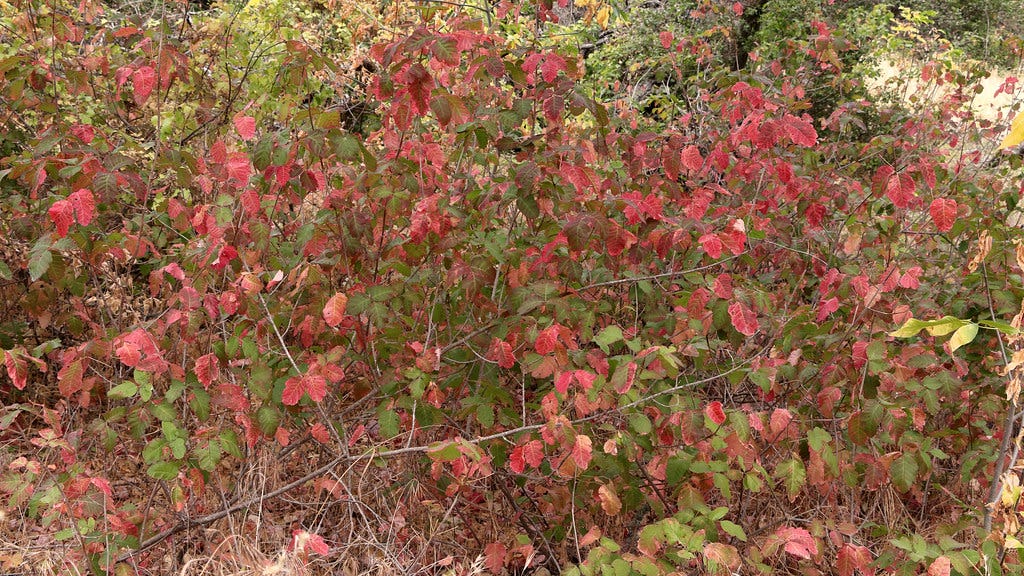
In the autumn, it was easy-peasy to see with its showy gorgeous red and orange toned leaves, looking like watercolour autumn sunsets. The colourful and shiny oily rounded edge leaves, looking innocent and calling out: wouldn’t we look lovely in a vase on the sideboard? Pick me pick me pick me! And in spring, the leaves would unfurl in the most lovely tender light green, full of innocence and potential glory, also looking like the perfect addition to a spring bouquet, perhaps for mothers day?

But I knew all it’s clothes, and how it grew, and where it grew, so I learned my own personal spidey sense in order to avoid it. Weirdly though I still managed to get it. I swear there were messengers sent from the plant out into the forest to track me down and slip those oily molecules of irritation all over my skin wherever it could be found. Usually the pesky irritating oily bumps would arise around my ankles in the warmer months, or at the tops and backs of my knees above my socks in the winter (We wore school uniforms that included wool skirts in winter and of course we wore thick cotton knee socks to keep our legs warm).
No matter what time of year, I would have a painful week of little bumps, and stinky calming calamine lotion, and hope that it didn’t get on my face. If (and when!) it did, it just added extra sheen to my already shiny acne-prone and scarred teenage face. Ugh. It was my life for four years.
Then I went away to university on the east coast for a couple of years, and to England for another year. All were glorious poison oak-free zones. And then I returned to Berkeley for my final two years of Geography studies and the amazing California field geography class. (See link for more about that class.)
This class meant we were outside every week for most of the autumn and early winter. And it was prime poison oak season! Luckily, for most of that time the leaves were abundant in all their autumn glory, and we could identify and avoid them. But as the semester wore on towards winter, and the bright leaves fell and we were left with the season of poison oak sticks, I used my special identifying skills to save me and my classmates from poison oak trauma. Perhaps this was the silver lining for my earlier four years of itchy skin?
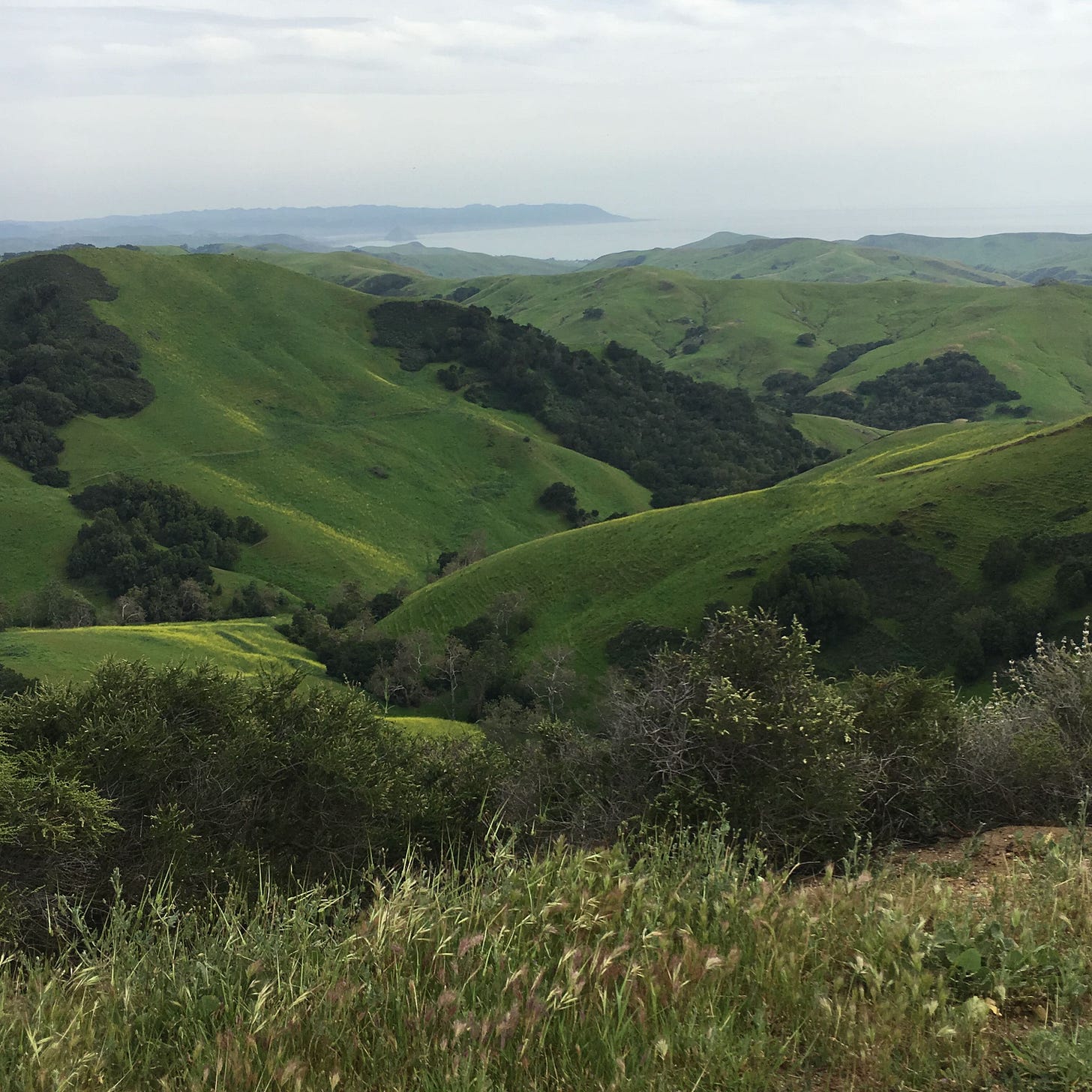
Although I live in the UK now, we still go to California regularly, and I remember what leaves to watch out for as we always go hiking somewhere with poison oak. I remind Pete what to watch out for as, even though he lived in California for 10 years, being English, he is not instinctively watching out for the distinctive shiny leaves. And thankfully he reminds me regularly to watch out for nettles on our walks here in the UK, as I am not instinctively aware of those, even after 13 years.
For those who don’t know, nettles are a mint-like looking leaf with tiny hairs on the leaves that when you brush them ever so slightly, inject a histamine and other chemicals into your skin that creates a stingy itchy sensation that doesn’t go away for a long time (hours/days). However, there are a few other interesting facts about nettles:
Unlike poison oak, nettles in the wild often grow adjacent to an antidote. If you grab some broad leaf dock, you can tear the leaves and rub them over the nettle burn and it allows for immediate and often permanent relief. According to wikipedia2, this is a folk remedy with no scientific justification, but since it has worked for me many times, I’ll continue to be happily duped into this apparently placebo effect. 😉
Nettles can be made into soup (I learned this from a California friend), but I haven’t tried that. Tempting fate and all…
Nettles soaked in water for a couple of weeks make a nice ‘soup’ for our other garden plants, and that is exactly what I do with these pesky sprouts (like the one in the photo above) which grow enthusiastically in our garden.
There are all kinds of other beneficial reasons, particularly for wildlife, that we should appreciate nettles, according to Wikipedia and the Royal Horticultural Society3, and the National Wildlife Trusts4.
So to give it an ‘equal review’ despite all my prejudices, here are some facts I learned about poison oak (same wikipedia link as in footnote 1):
California Native peoples used the leaves as a poultice against rattlesnake bites or to remove warts. In other words, poison oak is best used against something even more toxic than itself. 🤦🏽♀️
In a slightly more positive vein, it is used in habitat restoration projects as an early stage succession plant following woodland burns.
However, the smoke from burning poison oak is extremely hazardous and can manifest both internally and externally (give a thought to the firefighters during all the California wildfires). Also, be careful what you burn when making a campfire for s’mores!
The active compound in poison oak causing the skin irritation is also found in mango skin. Who knew? Now at least I understand why I don’t react well to mangos!
I don’t know about you, but I’d say that this is a hand-down win for nettles over poison oak, if one has to choose.
And why does this matter? It doesn’t really at all. I’ve been reminded of a part of my life that has since become a footnote, leaving me with a very small skill that I am able to share every once in awhile, even now. I’m grateful that there are always new things to learn, especially when you change places often, as I do. And it reminds me again why when I can’t grab hold of much else, geography and place are always how I find my way home.
And now, how about you? Do you have a specialist skill that you don’t get to use much anymore? Is that a good thing, or do you miss it? Are you allergic to any plants? Do you have a good nettle soup recipe? (I’m still a bit sceptical but have a seemingly endless supply…!)
Thanks for reading! If you liked reading this, feel free to click the ❤️ button on this post so more people can discover it on Substack 🙏
https://en.wikipedia.org/wiki/Toxicodendron_diversilobum
https://en.wikipedia.org/wiki/Urtica_dioica
https://www.rhs.org.uk/weeds/nettles-as-weeds
https://www.wildlifetrusts.org/wildlife-explorer/wildflowers/stinging-nettle

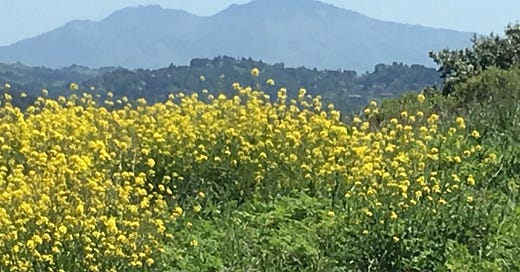




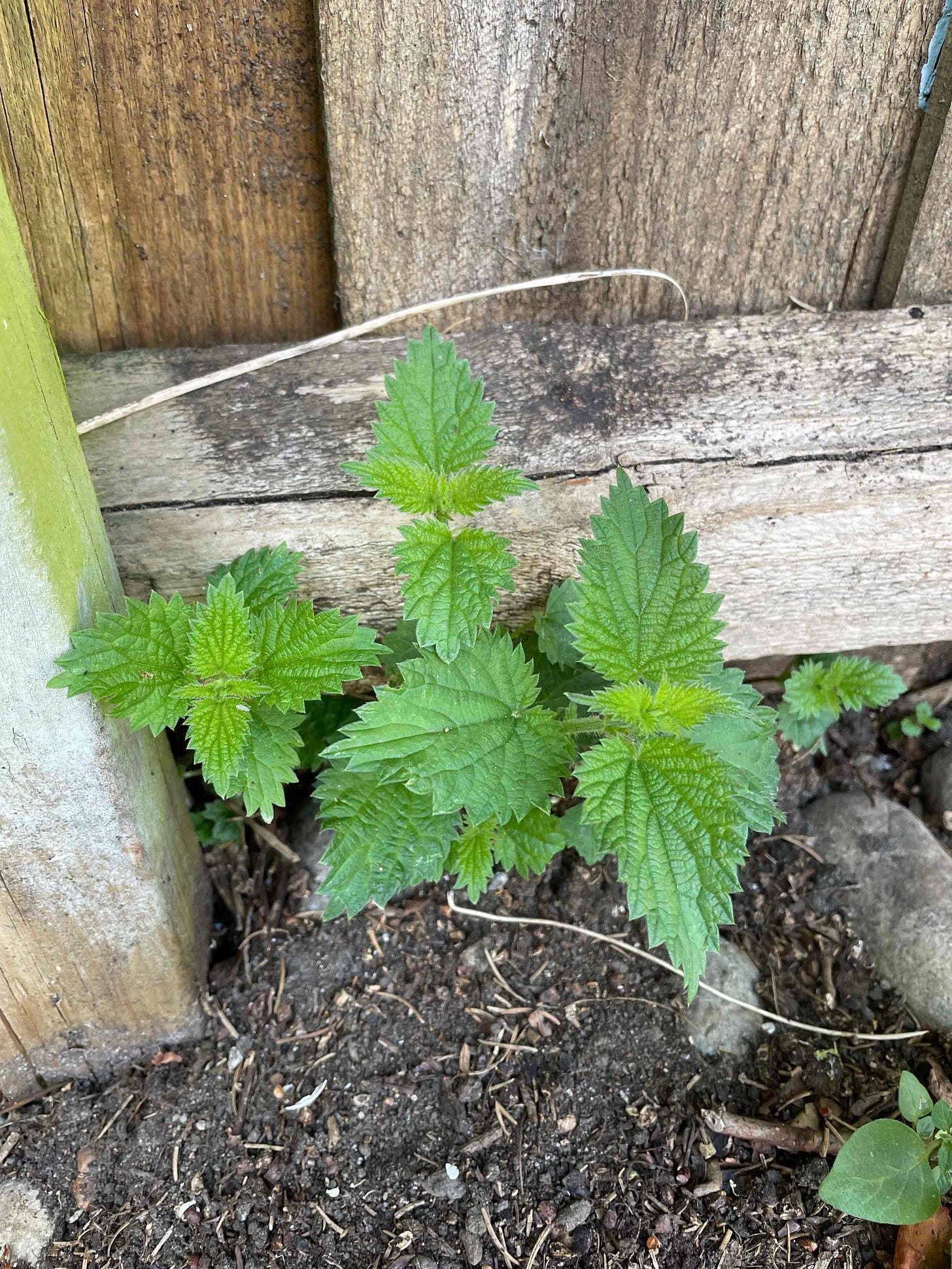
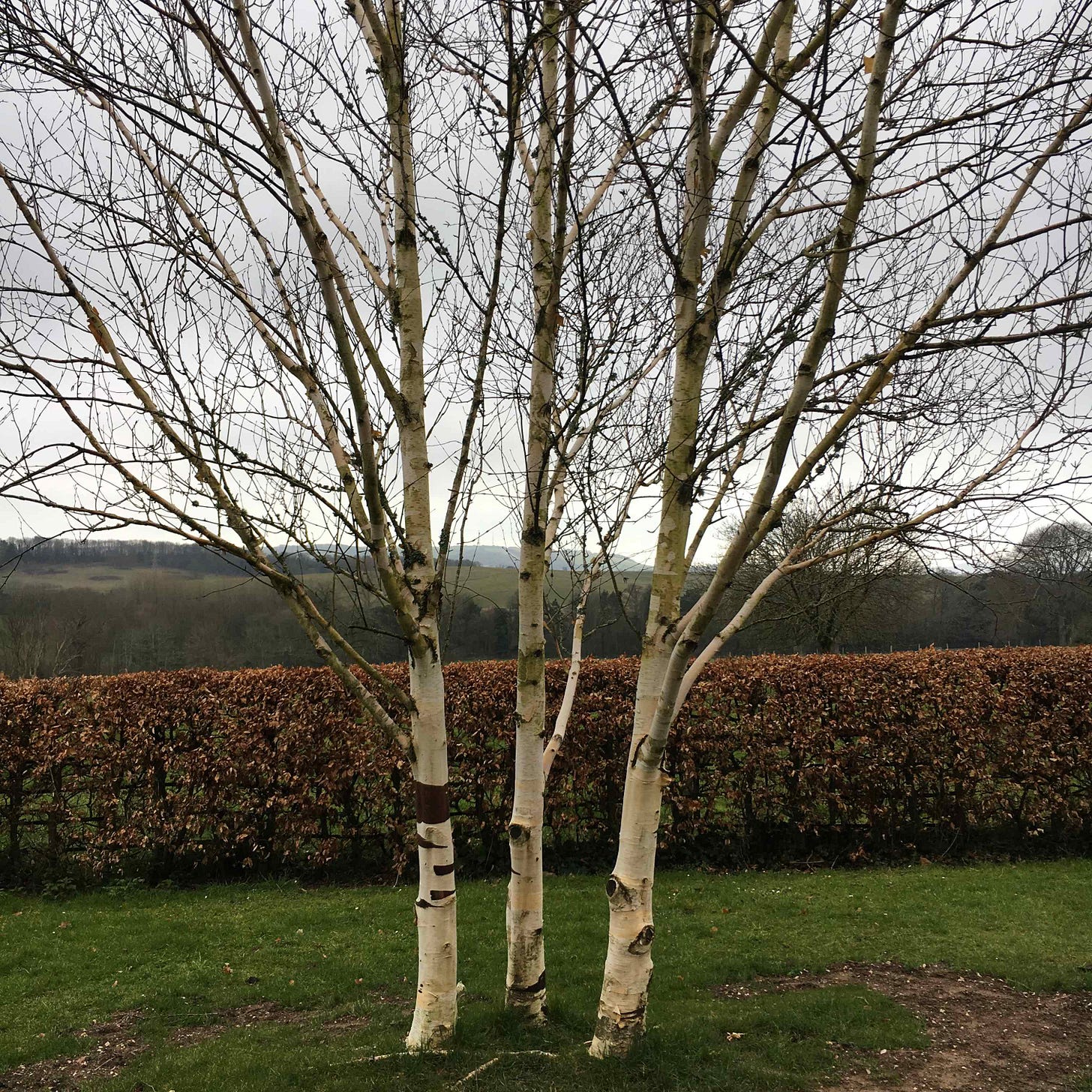
Funny how the topic of poison oak came up just yesterday. I was hiking around Mount Tamalpais. Stepping onto the trail, I immediately recalled the constant wariness that one needs looking out for and avoiding those shiny three leaved stems. The fear that I’ve brushed up against one. Those things are so ingrained in us we don’t forget.
I enjoyed reading this article not because it’s on one of my favorite topics by any means but it recalled the adventures going to and from your house to school. I also enjoyed how writing prompts bring up all kinds of things that one never imagines and how it’s good to raise those that are stored way down in the wells.
Hi Sabrina! One of my special super skills (still active) is sharing helpful info. And a tip that I found helpful for me, my family and anyone that I've shared it with, is this video on avoiding poison oak/ivy/sumac. It boils down to good hygiene, which is a helpful COVID tip as well when you think of it! Seriously worth a watch: https://www.youtube.com/watch?v=4oyoDRHpQK0 Poison oak rashes CAN be serious - a college classmate was written up in a medical journal re the severe burns she received from poison oak. UGH.